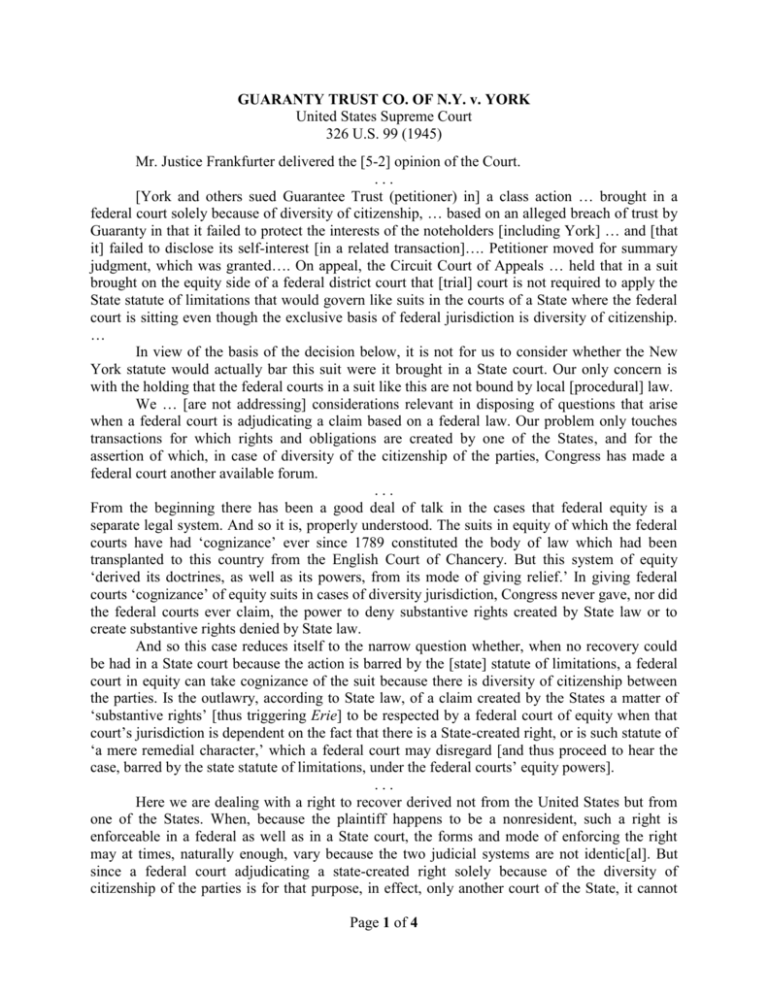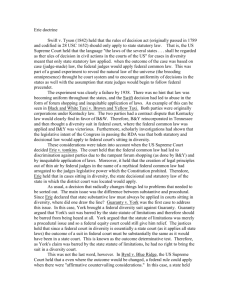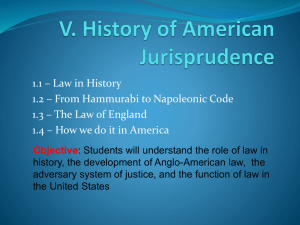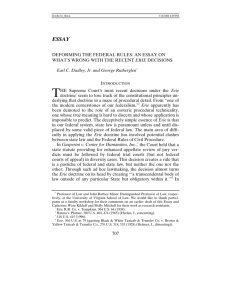York
advertisement

GUARANTY TRUST CO. OF N.Y. v. YORK United States Supreme Court 326 U.S. 99 (1945) Mr. Justice Frankfurter delivered the [5-2] opinion of the Court. ... [York and others sued Guarantee Trust (petitioner) in] a class action … brought in a federal court solely because of diversity of citizenship, … based on an alleged breach of trust by Guaranty in that it failed to protect the interests of the noteholders [including York] … and [that it] failed to disclose its self-interest [in a related transaction]…. Petitioner moved for summary judgment, which was granted…. On appeal, the Circuit Court of Appeals … held that in a suit brought on the equity side of a federal district court that [trial] court is not required to apply the State statute of limitations that would govern like suits in the courts of a State where the federal court is sitting even though the exclusive basis of federal jurisdiction is diversity of citizenship. … In view of the basis of the decision below, it is not for us to consider whether the New York statute would actually bar this suit were it brought in a State court. Our only concern is with the holding that the federal courts in a suit like this are not bound by local [procedural] law. We … [are not addressing] considerations relevant in disposing of questions that arise when a federal court is adjudicating a claim based on a federal law. Our problem only touches transactions for which rights and obligations are created by one of the States, and for the assertion of which, in case of diversity of the citizenship of the parties, Congress has made a federal court another available forum. ... From the beginning there has been a good deal of talk in the cases that federal equity is a separate legal system. And so it is, properly understood. The suits in equity of which the federal courts have had ‘cognizance’ ever since 1789 constituted the body of law which had been transplanted to this country from the English Court of Chancery. But this system of equity ‘derived its doctrines, as well as its powers, from its mode of giving relief.’ In giving federal courts ‘cognizance’ of equity suits in cases of diversity jurisdiction, Congress never gave, nor did the federal courts ever claim, the power to deny substantive rights created by State law or to create substantive rights denied by State law. And so this case reduces itself to the narrow question whether, when no recovery could be had in a State court because the action is barred by the [state] statute of limitations, a federal court in equity can take cognizance of the suit because there is diversity of citizenship between the parties. Is the outlawry, according to State law, of a claim created by the States a matter of ‘substantive rights’ [thus triggering Erie] to be respected by a federal court of equity when that court’s jurisdiction is dependent on the fact that there is a State-created right, or is such statute of ‘a mere remedial character,’ which a federal court may disregard [and thus proceed to hear the case, barred by the state statute of limitations, under the federal courts’ equity powers]. ... Here we are dealing with a right to recover derived not from the United States but from one of the States. When, because the plaintiff happens to be a nonresident, such a right is enforceable in a federal as well as in a State court, the forms and mode of enforcing the right may at times, naturally enough, vary because the two judicial systems are not identic[al]. But since a federal court adjudicating a state-created right solely because of the diversity of citizenship of the parties is for that purpose, in effect, only another court of the State, it cannot Page 1 of 4 afford recovery if the right to recover is made unavailable by the State nor can it substantially affect the enforcement of the right as given by the State. And so the question is … does it significantly affect the result of a litigation for a federal court to disregard a law of a State that would be controlling in an action upon the same claim by the same parties in a State court? It is therefore immaterial whether statutes of limitation are characterized either as ‘substantive’ or ‘procedural’ in State court opinions…. In essence, the intent of that decision [Erie] was to insure that, in all cases where a federal court is exercising jurisdiction solely because of the diversity of citizenship of the parties, the outcome of the litigation in the federal court should be substantially the same, so far as legal rules determine the outcome of a litigation, as it would be if tried in a State court. The nub of the policy … is that for the same transaction the accident of a suit by a non-resident litigant in a federal court instead of in a State court a block away, should not lead to a substantially different result. And so, … we have held that in diversity cases the federal courts must follow the law of the State as to burden of proof, as to conflict of laws, Klaxon Co. v. Stentor Co., 313 U.S. 487, [and] as to contributory negligence…. … Erie R. Co. v. Tompkins has been applied with an eye alert to … avoiding disregard of State law in diversity cases in the federal courts. A policy so important to our federalism must be kept free from entanglements with analytical or terminological niceties. Plainly enough, a statute that would completely bar recovery in a suit if brought in a State court bears on a [vital] State-created right…. As to consequences that so intimately affect recovery or non-recovery a federal court in a diversity case should follow State law … [and] the crucial consideration that if a plea of the statute of limitations would bar recovery in a State court, a federal court ought not to afford recovery. ... To make an exception to Erie R. Co. v. Tompkins on the equity side of a federal court [where federal judges would otherwise have the power to excuse delays in filing, based on the equities of the particular case] is to reject the considerations of policy which … led to that decision. Judge Augustus N. Hand thus summarized below the fatal objection to such inroad upon Erie R. Co. v. Tompkins: ‘In my opinion it would be a mischievous practice to disregard state statutes of limitation whenever federal courts think that the result of adopting them may be inequitable. Such procedure would promote the choice of United States rather than of state courts in order to gain the advantage of different laws. The main foundation for the criticism of Swift v. Tyson was that a litigant in cases where federal jurisdiction is based only on diverse citizenship may obtain a more favorable decision by suing in the United States courts.’ [citation omitted]. Diversity jurisdiction is founded on assurance to non-resident litigants of courts free from susceptibility to potential local bias. … And so Congress afforded out-of-State litigants another tribunal, not another body of law. The operation of a double system of conflicting laws in the same State is plainly hostile to the reign of law. Certainly, the fortuitous circumstance of residence out of a State of one of the parties to a litigation ought not to give rise to a discrimination against others equally concerned but locally resident. The source of substantive rights enforced by a federal court under diversity jurisdiction, it cannot be said too often, is the law of the States. Whenever that law is authoritatively declared by a State, whether its voice be the legislature or its highest court, such law ought to govern in litigation founded on that law, whether the forum of application is a State or a federal court and whether the remedies be sought at law or may be had in equity. Page 2 of 4 Dicta may be cited characterizing equity as an independent body of law. … But [such] notions … have been replaced by a sharper analysis of what federal courts do when they enforce rights that have no federal origin. … The judgment is reversed and the case is remanded for proceedings not inconsistent with this opinion. So ordered. Reversed. ... Mr. Justice Rutledge. I dissent. ... [There is a] divide between the substantive law and the procedural or remedial law to be applied by the federal courts in diversity cases, a division sharpened but not wiped out by Erie R. Co. v. Tompkins…. The large division between adjective law and substantive law still remains, to divide the power of Congress from that of the states and consequently to determine the power of the federal courts to apply federal law or state law in diversity matters. ... A long tradition, in the states and here, as well as in the common law which antedated both state and federal law, has emphasized the remedial character of statutes of limitations, more especially in application to equity causes. ... The state of the forum is free to apply its own period of limitations, regardless of whether the state originating the right has barred suit upon it. Whether or not the action will be held to be barred depends therefore not upon the law of the state which creates the substantive right, but upon the law of the state where suit may be brought. This in turn will depend upon where it may be possible to secure service of process, and thus jurisdiction of the person of the defendant. It may be therefore that because of the plaintiff’s inability to find the defendant in the jurisdiction which creates his substantive right, he will be foreclosed of remedy by the sheer necessity of going to the haven of refuge within which the defendant confines its ‘presence’ for jurisdictional purposes. The law of the latter may bar the suit even though suit still would be allowed under the law of the state creating the substantive right. ... In my judgment this furnishes added reason for leaving any change [which would limit federal equity power], if one is to be made, to the judgment of Congress. The next step may well be to say that in applying the doctrine of laches a federal court must surrender its own judgment and attempt to find out what a state court sitting a block away would do with that notoriously amorphous doctrine. ... Notes and Questions: 1. What was the issue in York? Justice Rutledge’s dissent refers to “laches.” What is that, and why is it important? 2. As York states, “such law ought to govern in litigation founded on that law, whether the forum of application is a State or a federal court.” That effectively means that state “procedure” would govern—in addition to state substantive law per Erie—in future diversity cases, so as to discourage any state-federal differences in diversity cases. ............................... Page 3 of 4 Federal courts sometimes describe a state-federal procedural difference as a substantive law variation. For example, “Each of these rules [citing, e.g., immunities, fee-shifting, and antiSLAPP motions] (1) would apply in state court had [the] suit been filed there; (2) is substantive within the meaning of Erie, since it is consequential enough that enforcement in federal proceedings will serve to discourage forum shopping and avoid inequity; and (3) does not squarely conflict with a valid federal rule” (underlining added). Adelson v. Harris, 774 F.3d 803, 809 (2014). But such variations are essentially differences in procedure. 3. Erie did not decide which state’s law should apply in an interstate context—nor, whether a federal judge was free to choose between a state’s internal substantive law, or its choice of law principles. That “choice,” if left open to a federal judge, could facilitate her arriving at a different decision than a state court judge. York refers (above) to Klaxton. Three years after Erie, Klaxton decided that a federal judge must apply the substantive law of the state in which s/he sits—including the forum’s choice of law rules, so as to promote uniformity of decision in state and federal diversity cases. Klaxton did not, however, address the issues raised in York. Page 4 of 4











